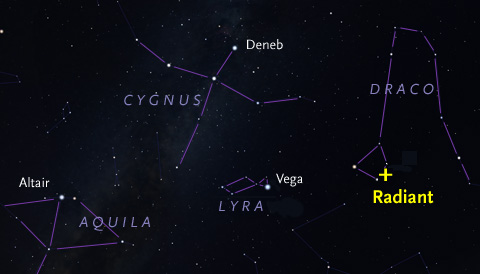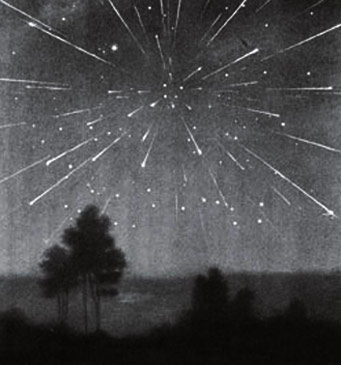Watch for any slow, unusual meteors starting at nightfall tonight and tomorrow.
Some meteor showers are as regular as the seasons, but the Draconid meteors of early October are wildly variable. Most years nothing happens. But in 1933 and 1946 the Draconids produced two of the great meteor storms of the last century. Certain other years have produced lesser displays, with rates ranging from 20 to more than 500 meteors visible per hour by an ideally placed observer.
But don't expect any cosmic fireworks this year. Even though the Moon is out of the picture (a waning crescent that doesn't rise until about 4 a.m.), the meteor pros predict that this year's Draconids might come at a zenithal hourly rate, or ZHR, at the low end. You might see one every 5 minutes or so from a dark location.

Source: Stellarium
The good news is that the shower's radiant lies near the head of Draco, a constellation that winds around Polaris and the Little Dipper. The radiant is highest in the evening, rather than in the morning hours as for most showers, so start watching at nightfall. The Draconids appear exceptionally slow-moving as meteors go; they are catching up to Earth from behind, so encounter velocities are only 20 km (12 miles) per second.
The Draconids are shed by Comet 21P/Giacobini-Zinner, a short-period comet in the Jupiter family that currently rounds the Sun about every 6.6 years. Most outbursts of Draconid meteors have happened in years close to the comet's perihelion, which it last reached in February 2012. That would suggest not much will happen in 2015, but with such a short-period comet you never know.
Nor is the timing of any possible shower very predictable. Activity in the recent past suggests that if we see anything this year, its brief peak could happen anytime from 21h Universal Time on the 8th (Thursday afternoon in the North American time zones) to 14h UT on the 9th (midday Friday in North America).

In 2011, bright moonlight and the shower's reputation for nonperformance resulted on only spotty amateur data. Too bad; the few counts that the International Meteor Organization received suggests that the ZHR that year hit 300. Researcher Josep Maria Trigo (Institute of Space Sciences, Spanish National Research Council) concludes that Earth passed in rapid succession through three dense streams of particles. Two of these streams were predicted to exist; the third was a surprise. A Draconid fireball over Spain rivaled the brightness of the waxing gibbous Moon in the same sky. Then in 2012 came a swarm of unusually faint Draconids, detected mostly by radar.
So even though no such outburst is predicted this year, you never know. So take some time to enjoy the great outdoors tonight — and maybe catch a few flecks shed by a passing comet.
To learn more about meteors and especially the famous Perseid meteor shower, which dazzles skywatchers every August, download our free "shooting stars" eBook.
 1
1
Comments
October 9, 2015 at 5:09 am
Was watching for them last night - nowhere close to a meteor every 5 minutes.. more like once every 20 minutes or so.
The site was decently dark, I could just make out mag 5 stars.
You must be logged in to post a comment.
You must be logged in to post a comment.